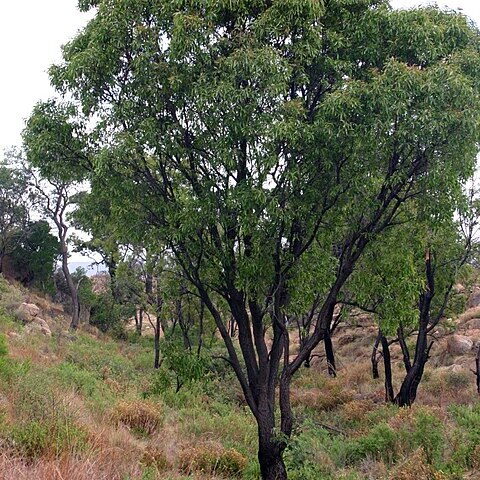Leaves glaucous green, upper surface sometimes slightly shiny, lanceolate-elliptic or narrowly lanceolate-elliptic, sometimes slightly falcate, up to 16 cm long and rarely more than 3-3.5 cm broad, usually 5-6 times as long as broad, acute at apex with a mucronate tip, tapering towards the base with a distinct petiole up to 1.5 cm long; midrib distinctly visible above but not prominent, on lower surface yellow and prominent, but secondary venation not obviously visible; surfaces entirely glabrous above except when very young, entirely glabrous beneath or sometimes with a few appressed hairs towards the base of the lamina; petioles pink or red, mostly glabrous or with minute appressed hairs.
A tree with a slende1; straight trunk and a willow-like appearance, normally 7-10 m tall but reaching 20 m i n KwaZulu-Natal. Bark dark grey to black. Wood pale yellow to red, with a beautiful grain; soaking in water yields a red dye. Leaves long and narrow, almost hairless, 65-125 mm long, 13-20 mm wide, lanceolate-elli ptic, slightly sickle-shaped, droopi ng, waxy, margi n entire, green in summ er and red in autumn; stalk 20 mm long Flowerheads in slender spikes 20-30 mm across, 120-150 mm long, green to cream-white, borne at branch tip, with a honey-or coconut-like scent. Flowers 12 mm long, densely covered with adpressed, grey hairs when young. Flowers: August to February.
Evergreen tree, 7-20 m high. Leaves alternate, entire and wavy, lanceolate-elliptic, slightly sickle-shaped, drooping, waxy, 65-125 x 13-20 mm, glabrous, thinly coriaceous, pale green turning red; petioles 20 mm long, pink. Inflorescence a slender hanging spike, 150 mm long, 30 mm wide, green to creamy white, densely covered with grey appressed hairs, honey-scented. Flowers bisexual, sessile, slightly irregular, each subtended by an ovate floral bract. Perianth: 3 adaxial segments fused into a sheath; abaxial segment separated, limbs lanceolate-elliptic. Flowering time Aug.-Feb. Fruit a nutlet covered with long hairs.
A tree. It grows 17 m tall. The young branches are light brown. The leaves are narrowly sword shaped. They are 16 cm long and 3-3.5 cm wide. The leaf stalk is 1.5 cm long. The flower heads are in slender spikes 2-3 cm across and 12-15 cm long. The flowers are 12 mm long. They are covered with grey hairs.
Perianth pink in bud, pale green when expanded but pinkish and brownish at base and apex of tube respectively, 1.2 cm long, tube with a slightly bulbous tip in bud 3-4 mm long, pubescent with greyish appressed hairs, densely so when young.
Small to medium-sized tree, up to 10 m high. Leaves lanceolate, pinkish red when young, bright red in autumn, petiole rosy red, drooping. Flowers sessile, spike 100-150 mm. Flowers greenish to creamy white.
Spikes up to 14 cm long, terminal; peduncle pubescent with greyish hairs; bracts deltoid, puberulous to pubescent.
Small to medium-sized tree up to 17 m high, usually with a slender ± straight trunk to first branch.
Young branchlets light brown with a grey appressed pubescence, glabrescent.
Hypogynous scales variable, ovate-triangular, 1–1.5 mm long.
Anthers 2.5-3 mm long.


